Themed collection Chemical Biology

The right touch: design of artificial antigen-presenting cells to stimulate the immune system
In this review we discuss the rapid developments on artificial structures meant to manipulate the immune system.
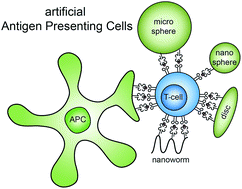
Chem. Sci., 2014,5, 3355-3367
https://doi.org/10.1039/C4SC01112K
Inteins: nature's gift to protein chemists
Inteins are a unique class of auto-processing domains with numerous applications in protein engineering and chemical biology.
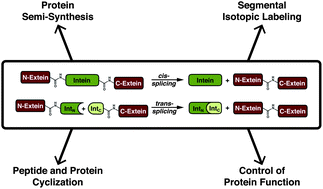
Chem. Sci., 2014,5, 446-461
https://doi.org/10.1039/C3SC52951G
Realizing the promise of chemical glycobiology
This review highlights recent advances and identifies the challenges and opportunities in chemical glycobiology, an emerging subfield of chemical biology.
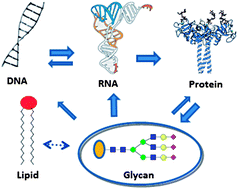
Chem. Sci., 2013,4, 3381-3394
https://doi.org/10.1039/C3SC50877C
Synthetically defined glycoprotein vaccines: current status and future directions
We highlight current glycovaccines in the clinic and derive principles for the construction of the next generation of synthetically defined glycoconjugate vaccines.

Chem. Sci., 2013,4, 2995-3008
https://doi.org/10.1039/C3SC50862E
On the reactivity and selectivity of donor glycosides in glycochemistry and glycobiology: trapped covalent intermediates
Chemistry meets biology: parallels between covalent intermediates in chemical glycosylation and enzymatic glycoside hydrolysis reactions.
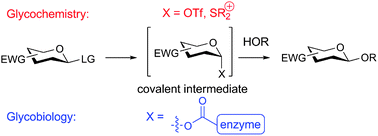
Chem. Sci., 2013,4, 897-906
https://doi.org/10.1039/C2SC21610H
Chemical biology toolkit for exploring protein kinase catalyzed phosphorylation reactions
Protein kinases catalyzed phosphorylations of peptide and protein substrates.
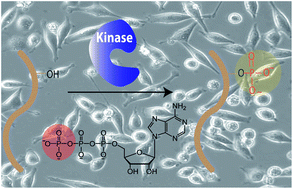
Chem. Sci., 2013,4, 42-59
https://doi.org/10.1039/C2SC20846F
Trimethyl lock: a trigger for molecular release in chemistry, biology, and pharmacology
The trimethyl lock provides unmatched attributes as a trigger for the release of small molecules by an enzymatic, chemical, or photolytic process.
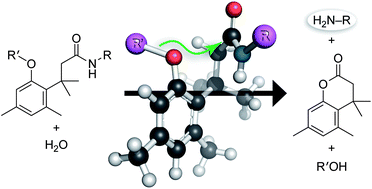
Chem. Sci., 2012,3, 2412-2420
https://doi.org/10.1039/C2SC20536J
Hydrogenases and oxygen
We summarize the current picture of oxygen-induced inhibition of the different classes of hydrogenases and discuss possible avenues that might lead to tailored oxygen-robust enzyme variants.
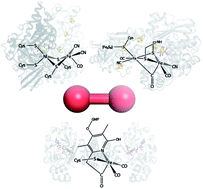
Chem. Sci., 2012,3, 1739-1751
https://doi.org/10.1039/C2SC01112C
Glucose conjugation for the specific targeting and treatment of cancer
This minireview discusses current progress in, and important considerations for, the emerging field of glycoconjugated anticancer therapeutics.
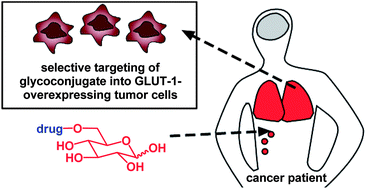
Chem. Sci., 2013,4, 2319-2333
https://doi.org/10.1039/C3SC22205E
Enzyme inhibition by metal complexes: concepts, strategies and applications
Metal complexes are increasingly being used to inhibit enzymes.
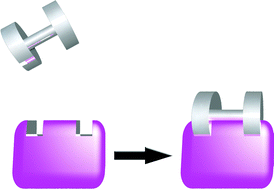
Chem. Sci., 2013,4, 1410-1419
https://doi.org/10.1039/C3SC22349C
Dressed for success – applying chemistry to modulate aptamer functionality
Chemical modifications modulate aptamer functionality and help to assert their full application potential.
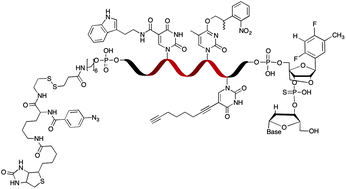
Chem. Sci., 2013,4, 60-67
https://doi.org/10.1039/C2SC21510A
Interactions of anticancer Pt compounds with proteins : an overlooked topic in medicinal inorganic chemistry?
An overview of the studies concerning the interactions of platinum anticancer agents with proteins/peptides is provided.
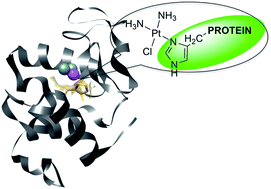
Chem. Sci., 2012,3, 3135-3144
https://doi.org/10.1039/C2SC20627G
DNA based multi-copper ions assembly using combined pyrazole and salen ligandosides
The pyrazole and salen ligandosides, when combined, are able to create stable multi-copper ion complexing DNA duplex structures in a cooperative fashion.
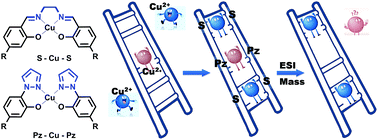
Chem. Sci., 2015,6, 632-638
https://doi.org/10.1039/C4SC01567C
Cytotoxic peptide–PNA conjugates obtained by RNA-programmed peptidyl transfer with turnover
A RNA triggered chemical peptidyl transfer reaction leads to a cytotoxic peptide conjugate that requires turnover in RNA for bioactivity.

Chem. Sci., 2014,5, 2850-2854
https://doi.org/10.1039/C4SC00299G
Functionalised staple linkages for modulating the cellular activity of stapled peptides
A divergent synthetic strategy for generating helical p53 peptides bearing functionalised staple linkages, allowing for efficient optimisation of cellular activity.
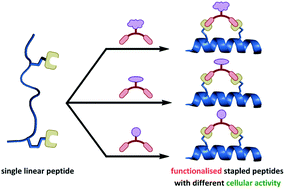
Chem. Sci., 2014,5, 1804-1809
https://doi.org/10.1039/C4SC00045E
Chemoenzymatic exchange of phosphopantetheine on protein and peptide
Evaluation of new acyl carrier protein hydrolase homologs from proteobacteria and cyanobacteria reveals significant variation in substrate selectivity and kinetics.
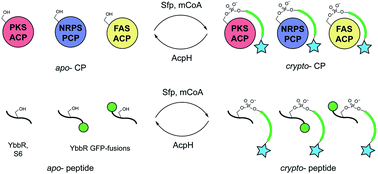
Chem. Sci., 2014,5, 1179-1186
https://doi.org/10.1039/C3SC53154F
Metallohelices with activity against cisplatin-resistant cancer cells; does the mechanism involve DNA binding?
Structure-dependent anticancer activity of metallo-helices, novel interactions with potential drug targets, and evidence of an apoptotic mechanism are presented.
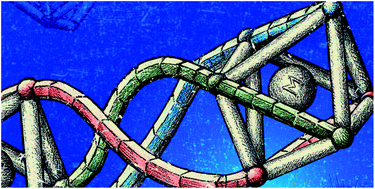
Chem. Sci., 2013,4, 4407-4416
https://doi.org/10.1039/C3SC51731D
Synthetic dityrosine-linked β-amyloid dimers form stable, soluble, neurotoxic oligomers
Dityrosine-linked Aβ dimers have been synthesized and display decreased rates of fibrilization and increased neuronal cell toxicity compared with the corresponding monomeric peptides.

Chem. Sci., 2013,4, 4449-4454
https://doi.org/10.1039/C3SC22295K
Specific recognition of DNA depurination by a luminescent terbium(III) complex
A terbium(III) complex exhibits sensitive luminescence response to purine bases in DNA, which can be used to recognize DNA depurination as a selective time-resolved luminescence probe.
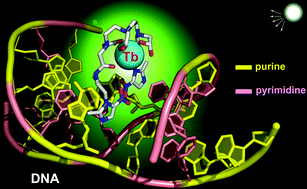
Chem. Sci., 2013,4, 3748-3752
https://doi.org/10.1039/C3SC51781K
Responsive MR-imaging probes for N-methyl-D-aspartate receptors and direct visualisation of the cell-surface receptors by optical microscopy
MR Imaging probes for NMDA receptors on a hybrid NSC-34 cell line show relaxation enhancements; the receptors have been visualised by microscopy and the specificity and reversibility of binding demonstrated.
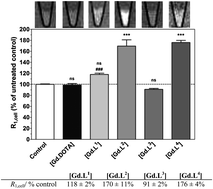
Chem. Sci., 2013,4, 3148-3153
https://doi.org/10.1039/C3SC50903F
A cyclic peptide inhibitor of C-terminal binding protein dimerization links metabolism with mitotic fidelity in breast cancer cells
A cyclic peptide inhibitor of the CtBP transcription repressor, discovered using a genetically encoded HTS platform, is used to link upregulated glycolytic flux to cell-cycle regulation in tumors.
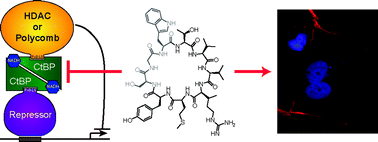
Chem. Sci., 2013,4, 3046-3057
https://doi.org/10.1039/C3SC50481F
Chemical fidelity of an RNA polymerase ribozyme
We challenge a polymerase ribozyme with an array of nucleotide variants to assess its tolerance of substrate heterogeneity. We uncover specificity determinants, and describe the implications for primordial RNA replication.
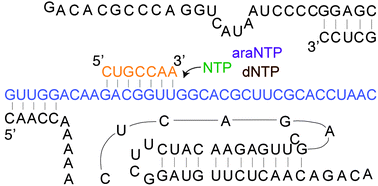
Chem. Sci., 2013,4, 2804-2814
https://doi.org/10.1039/C3SC50574J
Direct hydroxylation of primary carbons in small alkanes by wild-type cytochrome P450BM3 containing perfluorocarboxylic acids as decoy molecules
Primary carbons of propane and ethane are hydroxylated under high-pressure conditions of the alkanes (0.5 MPa) by wild-type P450BM3.
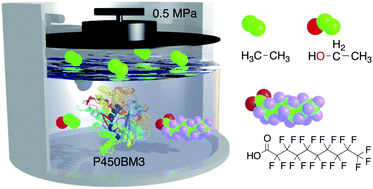
Chem. Sci., 2013,4, 2344-2348
https://doi.org/10.1039/C3SC50378J
Remodeling a β-peptide bundle
We apply the Rosetta algorithm to repack the hydrophobic core of a β-peptide bundle while retaining both structure and stability.
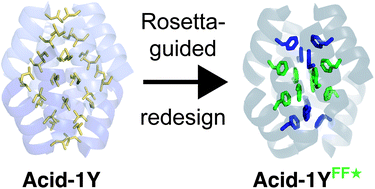
Chem. Sci., 2013,4, 319-324
https://doi.org/10.1039/C2SC21117C
Clickable, photoreactive inhibitors to probe the active site microenvironment of fatty acid amide hydrolase
To test the hypothesis that FAAH recruits its hydrophobic substrates directly from the cellular lipid bilayer, we have created clickable, photoreactive inhibitors that enable exploration of the enzyme's active site microenvironment in native cellular membranes.
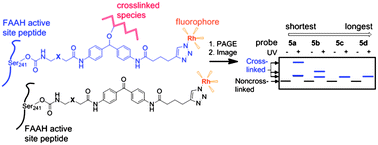
Chem. Sci., 2012,3, 77-83
https://doi.org/10.1039/C1SC00336D
A dendrimer-based platform for simultaneous dual fluorescence imaging of hydrogen peroxide and pH gradients produced in living cells
We present a modular dendrimer-based platform for simultaneous dual fluorescence imaging of hydrogen peroxide and pH gradients in the phagosomes of RAW 264.7 macrophages during immune insult.
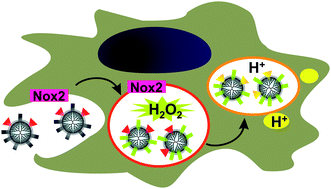
Chem. Sci., 2011,2, 1156-1165
https://doi.org/10.1039/C1SC00064K
About this collection
Looking for the best articles at the chemistry-biology interface? Associate Editors Professor Ben Davis and Professor Tom Muir, have picked some of their favourite articles recently published in Chemical Science. The collection showcases some of the great research papers and reviews published in Chemical Science in the areas of chemical biology and bioinorganic chemistry.